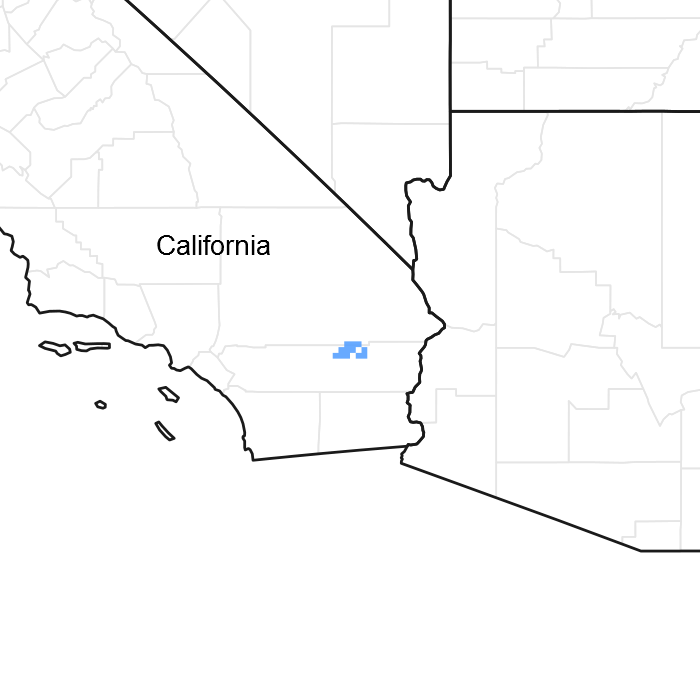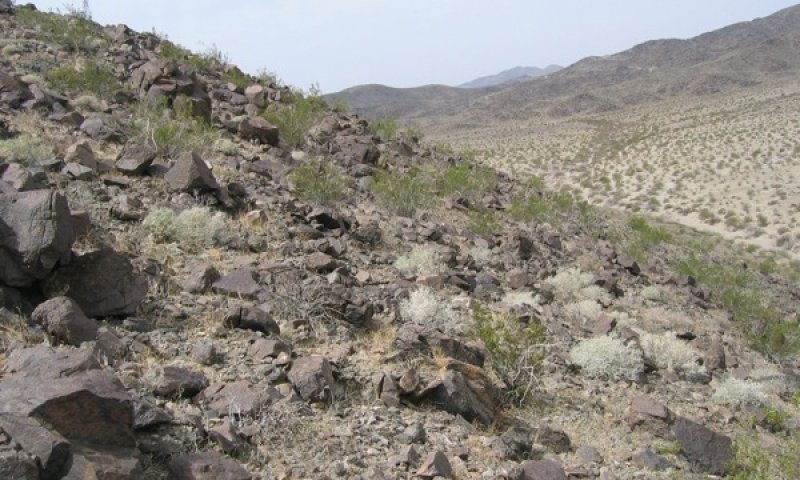

Natural Resources
Conservation Service
Ecological site R030XD001CA
Hyperthermic Dry Hills
Accessed: 12/22/2024
General information
Provisional. A provisional ecological site description has undergone quality control and quality assurance review. It contains a working state and transition model and enough information to identify the ecological site.

Figure 1. Mapped extent
Areas shown in blue indicate the maximum mapped extent of this ecological site. Other ecological sites likely occur within the highlighted areas. It is also possible for this ecological site to occur outside of highlighted areas if detailed soil survey has not been completed or recently updated.
MLRA notes
Major Land Resource Area (MLRA): 030X–Mojave Basin and Range
MLRA Description
Major Land Resource Area (MLRA) 30, Mojave Desert, is found in southern California, southern Nevada, the extreme southwest corner of Utah and northwestern Arizona within the Basin and Range Province of the Intermontane Plateaus. The climate of the area is hot (primarily hyperthermic and thermic; however at higher elevations, generally above 5000 feet, mesic, cryic and frigid) and dry (aridic). Elevations range from below sea level to over 12,000 feet in the higher mountain areas found within the MLRA. Due to the extreme elevational range found within this MLRA, Land Resource Units (LRUs) were designated to group the MLRA into similar land units.
LRU Description:
This Land Resource Unit (designated by ‘XD’) is found on the eastern side of California. Elevations range from 400 to 2200 feet on average, but may be found up to 3600 feet on southern exposures. Precipitation ranges from 1 to 6 inches per year, but averages between 2-4 inches. This LRU is characterized primarily by the extreme aridity, hot temperatures, hyperthermic soil temperatures and low stature of widely spaced vegetation. Temperatures can reach over 110 degrees Fahrenheit for several weeks in July and August. Summer precipitation falls between July and September, ranging from 20-33% in the form of rain, and winter precipitation falls starting in November and ends between February and March, ranging from 56-70%, also mostly in the form of rain. Vegetation is primarily small, widely-spaced, low-producing creosote bush (Larrea tridentata), burrobush (Ambrosia dumosa), and brittlebush (Encelia farinosa).
Ecological Site Concept -
This ecological site occurs on mountains, hills, steep sideslopes of fan remnants and basalt lava flows, on predominantly north-facing aspects at elevations of approximately 1000 to 2400 feet. At higher elevations this site may occur on all aspects. Soils are typically skeletal, with gravel surface textures, and range from very shallow to deep.
Production Reference Value (RV) is 255 pounds per acre and ranges from 70 to 431 pounds per acre depending on precipitation and annual forb production. This site is dominated by creosote bush (Larrea tridentata), and burrobush (Ambrosia dumosa) is an important secondary shrub. North-facing landscape positions on hyperthermic slopes favor dominance by creosote bush and burrobush.
The data in the following sections is from major (15% of mapunit or greater) components only.
Classification relationships
Mojave Creosote Bush (Holland 1986).
Larrea tridentata Shrubland Association (Sawyer et al. 2009).
Associated sites
| R030XD003CA |
Hyperthermic Steep South Slopes This ecological site occurs on adjacent south-facing slopes. Brittlebush (Encelia farinosa) is dominant. |
|---|---|
| R030XD004CA |
Low-Production Hyperthermic Hills This ecological site occurs on adjacent drier, north-facing slopes. Creosote bush (Larrea tridentata) is dominant. |
| R030XD014CA |
Hyperthermic Sandy Plains This ecological site occurs on adjacent sandsheets. Big galleta (Pleuraphis rigida) and creosote bush (Larrea tridentata) codominate. |
| R030XD152CA |
Hyperthermic Saline Hill This ecological site occurs on adjacent strongly alkaline lava flows. Desert holly (Atriplex hymenelytra) is dominant. |
Similar sites
| R040XD001CA |
Limy Hill 4-6" p.z. This ecological site occurs in MLRA31. Production is lower, especially of winter annuals. |
|---|---|
| R030XD004CA |
Low-Production Hyperthermic Hills This ecological site is found on similar soils and landform positions, but occurs in drier environments. Production and cover are lower, creosote bush (Larrea tridentata) is dominant and burrobush (Ambrosia dumosa) is trace if present. |
| R030XD040CA |
Hyperthermic Steep North Slopes This ecological site occurs on steep mountain slopes with a high percentage of rock outcrop and gullies. The site is co-dominated by burrobush (Ambrosia dumosa), creosote bush (Larrea tridentata) and brittlebush (Encelia farinosa), and shrub diversity and production are higher. |
Table 1. Dominant plant species
| Tree |
Not specified |
|---|---|
| Shrub |
(1) Larrea tridentata |
| Herbaceous |
(1) Pectocarya recurvata |
Click on box and path labels to scroll to the respective text.

